https://sputnikglobe.com/20230725/webb-telescope-in-first-ever-detects-water-in-planet-forming-region-1112125238.html
Webb Telescope in First-Ever Detects Water in Planet-Forming Region
Webb Telescope in First-Ever Detects Water in Planet-Forming Region
Sputnik International
This is the first detection of water in a disk that hosts at least two planets. The presence of water in the rocky planet-forming zone suggests the potential for habitability in these planets.
2023-07-25T03:23+0000
2023-07-25T03:23+0000
2023-07-25T03:25+0000
beyond politics
science & tech
european space agency (esa)
james webb space telescope (jwst)
space
space exploration
https://cdn1.img.sputnikglobe.com/img/07e6/07/0b/1097206042_0:225:985:779_1920x0_80_0_0_655dd7df00eb01477b0736bb30803c60.jpg
In a stunning discovery, scientists using the James Webb Space Telescope (JWST) have documented a cosmic first after detecting water in the inner region of a planetary disk surrounding the young star PDS 70. The observations, made by the Max Planck Institute for Astronomy (MPIA)-driven MINDS research collaboration, mark the first detection of water in a planet-forming region that hosts multiple planets. Additionally, the find offers new insights into the possibility of habitability on rocky planets forming in this zone.The presence of water in the inner disk of PDS 70 indicates the potential for a substantial local water reservoir, which greatly improves the chances of habitability for any rocky planets that may form within the site. Having suggested water could serve as an initial ingredient of rocky planets and that it may be available at birth, the groundbreaking find challenges previous theories that water is primarily supplied by water-bearing asteroids bombarding a young planet's surface.The water was discovered near the disk center, close to the host star PDS 70, which is the region where rocky planets similar to Earth typically form. The water was found in the form of hot vapor, with a temperature of approximately 330 degrees Celsius.While no planets have been detected near the PDS 70 disk center, two gas-giant planets, PDS 70 b and c, were found farther out. These planets likely accumulated surrounding dust and gas during their growth, creating an annular gap with minimal detectable material.The detection of water in the inner disk of PDS 70 opens up new possibilities for understanding the origin and availability of water on rocky exoplanets. Further research and observation will be conducted to explore the potential habitability of these planets and the mechanisms involved in their formation.The findings of the study were published in the journal Nature.
https://sputnikglobe.com/20230720/bffs-astronomers-spot-two-planets-appearing-to-share-same-orbit-1112021016.html
Sputnik International
feedback@sputniknews.com
+74956456601
MIA „Rossiya Segodnya“
2023
News
en_EN
Sputnik International
feedback@sputniknews.com
+74956456601
MIA „Rossiya Segodnya“
Sputnik International
feedback@sputniknews.com
+74956456601
MIA „Rossiya Segodnya“
james webb space telescope jwst, is there water in space, which planets have water besides earth, latest space exploration discoveries, inner disk of pds 70, for what is mid-infrared instrument used, european space agency
james webb space telescope jwst, is there water in space, which planets have water besides earth, latest space exploration discoveries, inner disk of pds 70, for what is mid-infrared instrument used, european space agency
Webb Telescope in First-Ever Detects Water in Planet-Forming Region
03:23 GMT 25.07.2023 (Updated: 03:25 GMT 25.07.2023) Earlier, the PDS 70 system - a young star in the constellation Centaurus - was reported to be hosting two planets that share the same orbit some 370 light-years from Earth. Officials speculated the possibility after a debris cloud was detected in the same orbit as PDS 70b.
In a stunning discovery, scientists using the James Webb Space Telescope (JWST) have documented a cosmic first after detecting water in the inner region of a planetary disk surrounding the young star PDS 70.
The observations, made by the Max Planck Institute for Astronomy (MPIA)-driven MINDS research collaboration, mark the first detection of water in a planet-forming region that hosts multiple planets. Additionally, the find offers new insights into the possibility of habitability on rocky planets forming in this zone.
“We now may have found evidence water could also serve as one of the initial ingredients of rocky planets and be available at birth,” said Giulia Perotti, an astronomer at the MPIA who also serves as the main author of the study.
The presence of water in the inner disk of PDS 70 indicates the potential for a substantial local water reservoir, which greatly improves the chances of habitability for any rocky planets that may form within the site.
Having suggested water could serve as an initial ingredient of rocky planets and that it may be available at birth, the groundbreaking find challenges previous theories that water is primarily supplied by water-bearing asteroids bombarding a young planet's surface.
The water was discovered near the disk center, close to the host star PDS 70, which is the region where rocky planets similar to Earth typically form. The water was found in the form of hot vapor, with a temperature of approximately 330 degrees Celsius.
PDS 70 is a relatively old disk, approximately 5.4 million years old, making it the first disk of its age where water has been detected.
Previous studies failed to detect water in the central regions of similarly evolved disks, leading scientists to believe it might not survive the harsh stellar radiation. However, the observations made by the JWST challenge this hypothesis, suggesting the inner perimeters of evolved and dust-depleted disks may not be as dry as previously thought.
While no planets have been detected near the PDS 70 disk center, two gas-giant planets, PDS 70 b and c, were found farther out. These planets likely accumulated surrounding dust and gas during their growth, creating an annular gap with minimal detectable material.
The detection of water in the inner disk of PDS 70 opens up new possibilities for understanding the origin and availability of water on rocky exoplanets. Further research and observation will be conducted to explore the potential habitability of these planets and the mechanisms involved in their formation.
The James Webb Space Telescope (JWST), a groundbreaking observatory for space research, has been at the forefront of international collaboration. Led by NASA in partnership with the European Space Agency (ESA) and the Canadian Space Agency (CSA), the JWST has united scientists from various institutions across Europe.
One key component of the JWST is the Mid-InfraRed Instrument (MIRI), a versatile scientific instrument designed for infrared wavelengths ranging from 5 to 28 microns. MIRI was built by a consortium of European research institutions.
The findings of the study were published in the journal
Nature.



